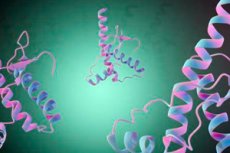
朊病毒是一种异常病原体,能够传播并导致某些正常细胞蛋白质发生错误折叠。朊病毒病是一类无法治愈且致命的神经退行性疾病的统称,这些疾病不仅影响人类,也影响野生动物和家畜。这些疾病包括人类的克雅氏病(CJD)、牛的牛海绵状脑病(BSE,又称“疯牛病”)以及影响鹿、麋鹿和驼鹿的慢性消耗性疾病 (CWD)。
这些疾病的关键事件是朊病毒蛋白(PrPC)从正常形式转化为病理结构(PrPSc)。PrPSc对神经元具有毒性,并且可以通过与未转化的PrPC分子结合进行自我复制。这种自我复制能力使这些错误折叠的蛋白质具有传染性,对公共卫生造成巨大影响。
在一项新研究中,波士顿大学 Chobanian 和 Avdisian 医学院的研究人员发现了 10 种能够降低受感染细胞中 PrPSc 水平的化合物,并表明最有效的分子还可以防止 PrPSc 应用于培养神经元时出现的毒性。
“令人兴奋的是,其中五种分子已经用于医疗:用于治疗神经精神疾病的林卡唑和氟哌啶醇,用于治疗神经性疼痛的(+)-喷他佐辛,以及分别用于治疗缺血性中风和阿尔茨海默病的临床试验中的 SA 4503 和 ANAVEX2-73,”该学院生物化学和细胞生物学教授、主要作者 Robert SS Mercer 博士解释道。
研究人员最初研究这些分子的抗朊病毒特性,是因为它们已知能够与σ受体(σ1R和σ2R)结合,而σ受体被认为与朊病毒增殖有关。利用基因敲除技术(CRISPR),他们发现σ受体并非这些药物抗朊病毒特性的靶点。
使用来自实验性朊病毒感染模型的 Neuro2a (N2a) 细胞,将这些细胞暴露于浓度递增的每种药物中,并测定 PrPSc 水平。随后,他们使用 CRISPR 技术“编辑”了 σ1R 和 σ2R 基因,使其不再编码该蛋白质,并发现这对药物所观察到的 PrPSc 水平降低没有影响。这使他们得出结论,σ1R 和 σ2R 并非这些药物抗朊病毒作用的原因。随后,他们测试了这些药物抑制 PrPC 转化为 PrPSc 的能力,发现它们对细胞外的这些反应没有影响,这表明另一种蛋白质参与了药物的作用。
研究人员表示,朊病毒疾病对公共卫生有着巨大的影响,从血液供应的安全到神经外科手术器械的正确消毒,都与此息息相关。“从临床角度来看,我们认为这项研究发现了一些已被证明可安全用于人体的药物的抗朊病毒特性。正因如此,尤其是在目前缺乏针对这些疾病的有效治疗方法的情况下,这些化合物或许可以被重新用于治疗朊病毒疾病,”该校生物化学与细胞生物学系教授兼系主任、医学博士、哲学博士、资深研究作者David A. Harris说道。
该研究结果在线发表于ACS Chemical Neuroscience杂志上。

